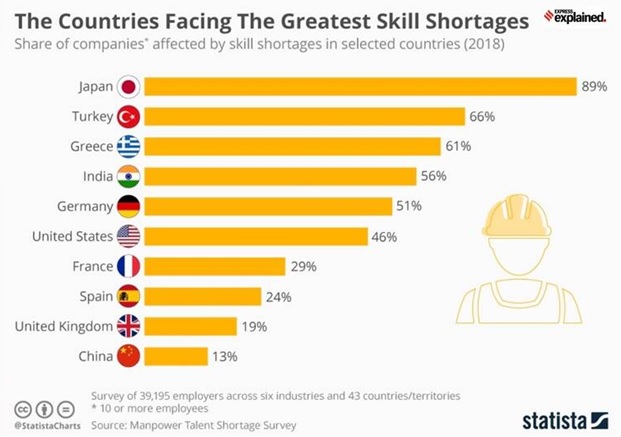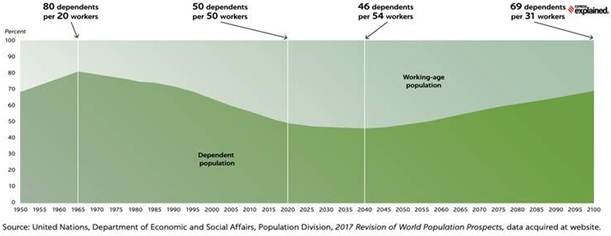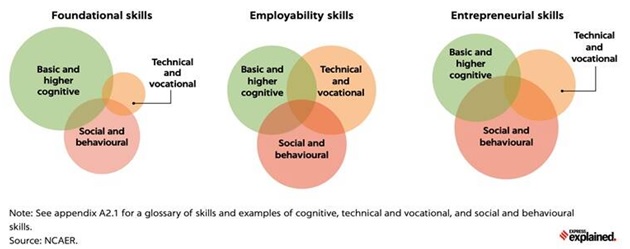(Mains GS 3 : Indian Economy and issues relating to planning, mobilization, of resources, growth, development and employment.)
Context:
- Recently, World Youth Skills Day was observed on 15 July which yet again shows the importance of a skilled workforce in India for achieving the goal of becoming Atmanirbhar Bharat.
India still has unskilled workforce:
- Indian administration runs many schemes and programmes such as the Skill India Mission and the ‘Going Online As Leaders’ (or Goal) etc.
- These programmes in India had laid the foundation for improving the level of skill among the youth.
- However, according to most estimates, India continues to be a country that faces one of the highest shortages of skilled workforce.

This is just one side of the problem.
- Unskilled workforce is just one side of the problem and another side is the massive unemployment in India — one that worsens with educational attainment.
- The data for January to April 2021 period shows that the overall unemployment rate in the country was 6.83%.
- In comparison, those with graduation (or even higher degrees) face almost three-times the unemployment level.
- At over 19% unemployment rate, one in every five Indian who graduate (or even better) is unemployed.
- It is almost as if the economy penalises you for getting educated.
The lack of skill:
- On the one hand, companies in India face an acute shortage of skilled manpower and, on the other, India has millions of educated unemployed.
- However, it is important to understand the meaning of “skilling”.
- A good resource in this regard is the 2018 report by the National Council of Applied Economic Research, titled “No time to lose”.
- This report explains that there are three types of skills.
- First, the cognitive skills, which are the basic skills of literacy and numeracy, applied knowledge and problem-solving aptitudes and higher cognitive skills such as experimentation, reasoning and creativity.
- Then there are the technical and vocational skills, which refer to the physical and mental ability to perform specific tasks using tools and methods in any occupation.
- Lastly, there are social and behavioural skills, which include working, communicating, and listening to others.
- Different levels of these three types of skills can be combined to further classify skills into foundational, employability, and entrepreneurial skills.

The scale of the skilling challenge India facing:
- According to the 2018 report by NCAER, India had about 468 million people in its workforce among them around 92% were in the informal sector.
- Around 31% were illiterate, only 13% had a primary education, and only 6% were college graduates.
- Further, only about 2% of the workforce had formal vocational training, and only 9% had non-formal, vocational training.
- That report had also estimated that almost 1.25 million new workers (aged 15–29) were projected to join India’s workforce “every month” through 2022.
- Another noteworthy observation in that report was that out of the more than 5 lakh final year bachelors students aged 18–29 who were surveyed, around 54% were found to be “unemployable.
- Thus, if the skilling issue is not resolved, India risks forfeiting its so-called “demographic dividend”.
High time for demographic dividend:
- The chart below shows that, India’s working-age population (light green area) is growing faster than its population of young and old dependents (dark green area).
- There is great opportunity for India to improve both its social and economic outcomes if the higher number of workers are productively employed.
- At precisely the year 2020, the proportion of those Indians who belong to the working age (15 to 64 years of age) and those who are dependent will be 50-50.
- Between 2020 and 2040, this proportion will turn even more favourable.

India needs to be prosperous fast:
- The opportunity of demographic dividend will depend entirely on how many of those in the working age bracket are working and becoming prosperous.
- If they are not in well-paying jobs, the economy would not have the resources to take care of itself since with each passing year, the proportion of dependents will continue to rise after 2040.
- Thus, to attain its rightful place and realise its aspirations, India must become rich before it gets old.
India’s domestic skilling paradox:
- Indians have excelled in technical expertise at the global level — be it medicine or engineering.
- But at home, over 90% of India’s workforce is in the informal sector.
- According to researchers at the NCAER, India is trapped in a vicious cycle: Greater workforce informality leads to lower incentives to acquire new skills.
- Faced with inadequately skilled workers, businesses often choose replacing labour with machinery.
- That’s because “skilled labour and technology are complementary, but unskilled labour and technology are substitutes”. This, in turn, leads to still fewer formal jobs.
- Millions of Indians who work in agriculture continue to subsist because they do not have the skills to take up industrial or services sector jobs even as these sectors themselves have failed to create adequate job opportunities.
Way forward:
- A distinct disadvantage with India’s approach towards skilling has been to ignore the demands of the market.
- For the most part, skills have been provided in a top down fashion.
- Thus, most skilling efforts focus almost solely on providing certain skills but fail to “match” them with the needs of the market.
- Experts argue that for skilling schemes to yield lasting results, even matching is not enough.
- Given the way market demands fluctuate — for instance, Covid pandemic has upended supply chains — skilling efforts must try to anticipate the needs of the market.


